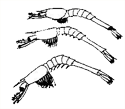Shrimp Life Cycle
 1. Eggs Shrimp eggs are thought to sink to the bottom at the time of spawning. Egg diameter is less than 1/64 in. Most spawning is believed to occur in high salinity oceanic waters. |
 5. Postlarva The two postlarval stages for white shrimp are about 1/6 to 1/4 in. Brown shrimp postlarvae are larger, up to 1/2 in. The walking and swimming legs have developed and the postlarvae appear as miniature shrimp. The second postlarval stage rides the flood tides into the estuaries, apparently becoming active during flood tide and settling to the bottom during ebb tides. The postlarvae ultimately settle in the upper parts of tidal creeks. |
 7. Sub-adults Sub-adults move into the deeper waters of the estuaries and may remain there for a month or more before moving seaward. These shrimp continue to grow but at a slower rate than juveniles. Sub-adults usually do not exhibit any signs of ovarian maturity.  |
 2. Nauplius There are five naupliar stages. The first stage is about the size of the egg and succeeding stages are slightly larger. Nauplii have limited swimming ability and usually are a part of the oceanic plankton. |
||
 3. Protozoea The three protozoeal stages range in size from 1/25 to 1/12 in. These planktonic forms are found in oceanic waters. Protozoea have undergone development of their mouth parts and the abdomen has begun to develop. |
 6. Juvenile Postlarval shrimp develop directly into juvenile shrimp. Growth is rapid, up to 2 1/2 in. per month. Juveniles are similar to adults except they are characterized by a much longer rostrum (horn). Juveniles typically remain in the marsh creeks until reaching about 4 to 4 1/2 in. before moving into the deeper rivers. |
8. Adults Adults may be 5 to 8 inches in length. Adults are usually found in the ocean, but in dry years may delay migration until cold weather occurs. Spawning females are characterized by brightly colored ovaries that can be seen under the shell on the upper side of the body. Adults may be found near the beaches out to 5 or 6 miles from shore. Some species are known to migrate hundreds of miles along the coast. |
 4. Mysis There are three mysid stages ranging in size from 1/8 to 1/5 in. These are planktonic in the ocean. Mysids have early development of legs and antennae. |
This publication was made possible in part with funds from the sale of the South Carolina Saltwater Recreational Fishing License and the U.S. Fish and Wildlife Service Sportfish Restoration Fund. The South Carolina Department of Natural Resources publishes an annual Rules and Regulations booklet that lists all saltwater fishing regulations. Have an enjoyable fishing trip by reading these requirements before you fish.
Author credentials: J. David Whitaker, Peter Kingsley-Smith of the Marine Resources Division
The above information on shrimp is available in a brochure, please download the Sea Science - Shrimp information pamphlet which is in the Adobe PDF file format. Adobe® Reader® is required to open the files and is available as a free download from the Adobe® Web site.
